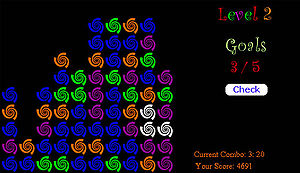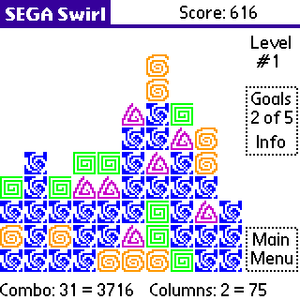
Sega Swirl
Encyclopedia


Personal computer
A personal computer is any general-purpose computer whose size, capabilities, and original sales price make it useful for individuals, and which is intended to be operated directly by an end-user with no intervening computer operator...
, and Palm OS
Palm OS
Palm OS is a mobile operating system initially developed by Palm, Inc., for personal digital assistants in 1996. Palm OS is designed for ease of use with a touchscreen-based graphical user interface. It is provided with a suite of basic applications for personal information management...
. The game was included in various demo discs released for the Dreamcast (through the Official Dreamcast Magazine (UK)
Official Dreamcast Magazine (UK)
The Official Dreamcast Magazine was a video game magazine published by Dennis Publishing in the United Kingdom between 1999 and 2001. The magazine featured news, reviews, previews and features on Dreamcast games. The magazine held the official magazine license for the Dreamcast in the UK and...
and Official Dreamcast Magazine (US)
Official Dreamcast Magazine (US)
The Official Dreamcast Magazine was a video game magazine for the Dreamcast published in the United States. The magazine's initial issue "0" was released in June 1999, a full 3 months before the launch of the system. This rare issue featured Sonic the Hedgehog on a black cover, along with the...
magazines, and on newly released consoles), and is free to download and play on the PC.
Sega Swirl was created by Scott Hawkins, while he worked at Sega
Sega
, usually styled as SEGA, is a multinational video game software developer and an arcade software and hardware development company headquartered in Ōta, Tokyo, Japan, with various offices around the world...
. Scott Hawkins designed the game and programmed the original PC version of the game. Scott Hawkins worked with Tremor Entertainment to develop the Dreamcast version of the game.
The game presented swirls of different colors stacked upon each other. The player would try to match up as many of the same colored swirls onscreen as possible, then, when satisfied with a combo, they would press the color, making them disappear. The more swirls one can gather together, the more points earned, as well as a reward of seeing the swirls disappear in different ways. The most rewarding way to see the swirls disappear is when they all go into the air and burst with firework-like sounds and cheers. If a swirl of a certain color is alone within a stack of other colored swirls, the player actually loses points.
The Dreamcast version featured a snake in the bottom right corner of the screen, who would act pleased when the player did well and shook his head when they did poorly. If the player did nothing for an extended length of time, the snake would stare at them and then gesture to the left, towards the play field.
On the Dreamcast, it could be played on Versus mode (players compete with one Swirl screen) with up to four players, and it also allowed Split Screen (four players with their own swirl play fields). On the PC, split screen is not available, and versus is up to two players. Both versions allowed one to compete with another human player via email
Email
Electronic mail, commonly known as email or e-mail, is a method of exchanging digital messages from an author to one or more recipients. Modern email operates across the Internet or other computer networks. Some early email systems required that the author and the recipient both be online at the...
(Dreamcast players may also play against PC players through this).
The Palm version of Sega Swirl includes a two player head-to-head mode that can be played in real-time over the handheld's infrared port.

